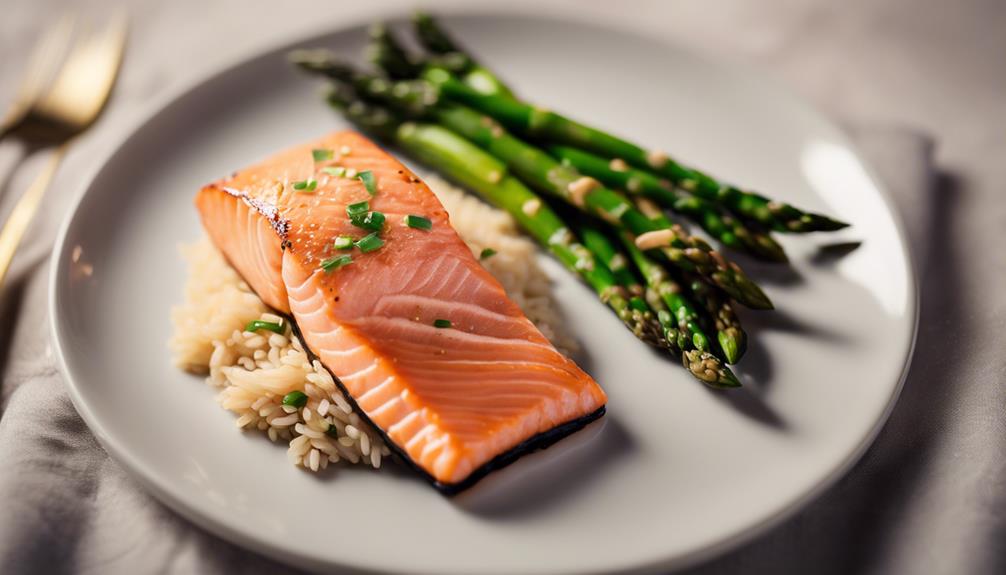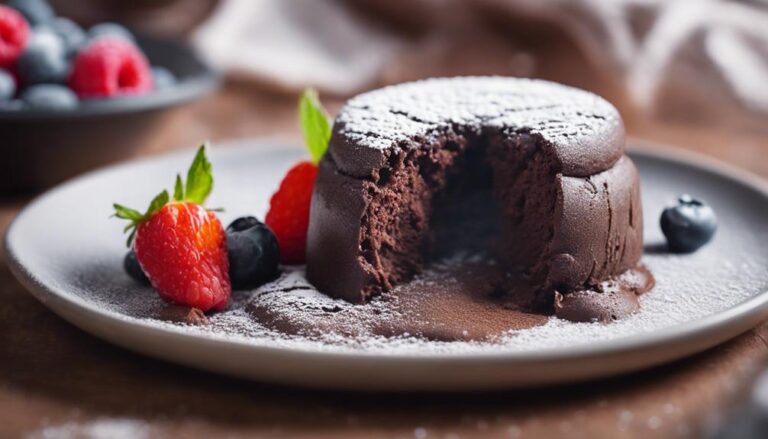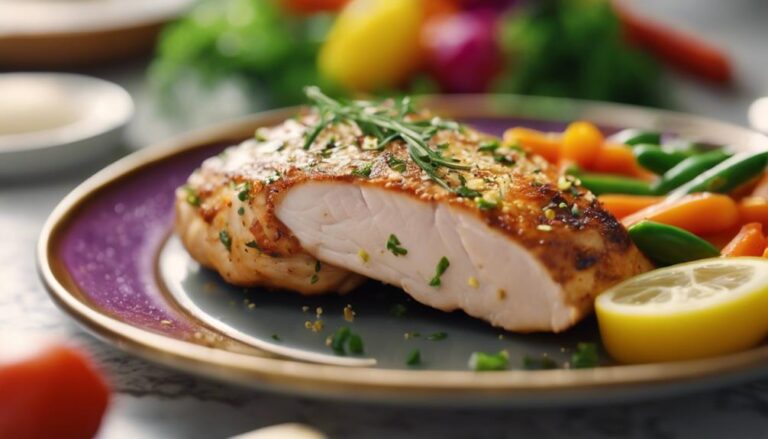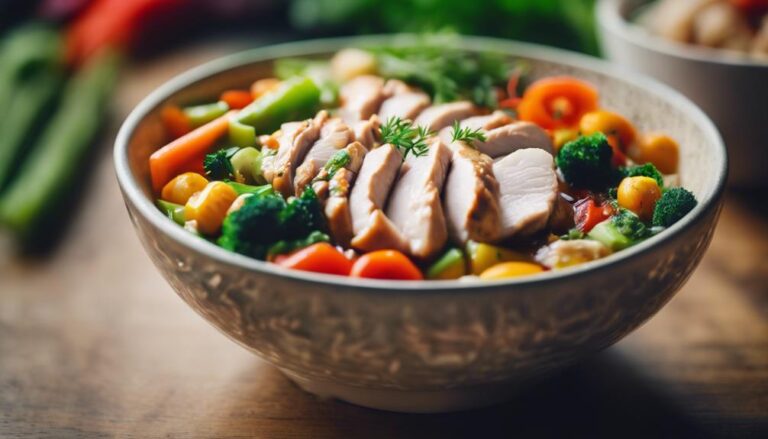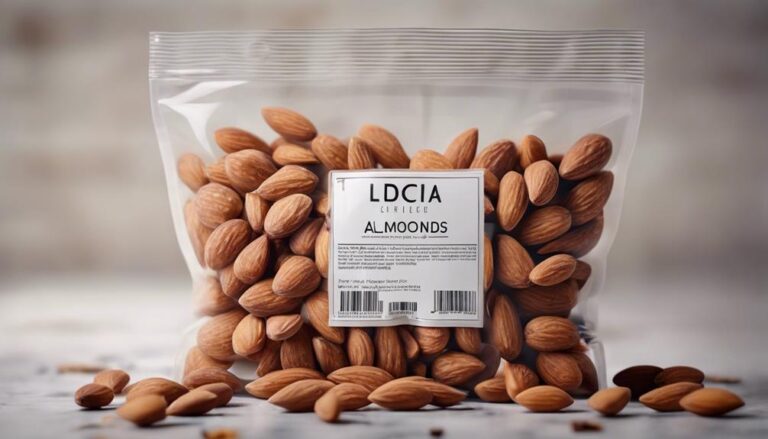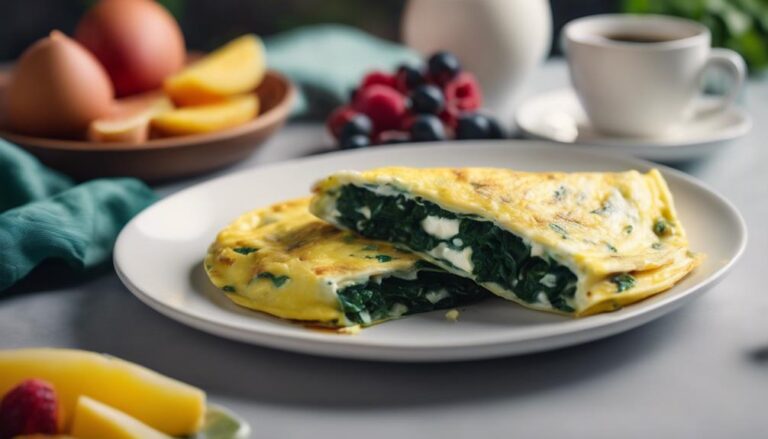Lunch Sous Vide Salmon With Asparagus and Brown Rice for the 80/20 Diet
To make a nutritious lunch for the 80/20 Diet, try sous vide salmon with asparagus and brown rice. This method seals in the flavors of the fresh salmon, asparagus, and brown rice for a delicious meal. With precise temperature control, your salmon will turn out perfectly cooked and tender. Pair it with whole grain brown rice and fiber-rich asparagus for a balanced plate. For more tips on preparing this delectable dish, find out how sous vide cooking enhances the taste of your ingredients to create a healthy and satisfying meal.
What You Will Learn Here
- Sous vide salmon with asparagus and brown rice is a nutritious 80/20 diet meal.
- Precise temperature control in sous vide enhances flavors and retains nutrients.
- Vacuum sealing locks in moisture and intensifies natural flavors in the dish.
- Cooking time control ensures perfectly tender salmon and crisp asparagus.
- Balanced meal with omega-3 rich salmon, fiber-filled asparagus, and nutrient-dense brown rice.
Culinary Origins

Sous vide cooking has a rich history that dates back to early preservation methods, where food was vacuum-sealed and slow-cooked in water baths.
Today, modern culinary techniques have elevated sous vide to an art form, allowing for precise temperature control and ideal flavor retention.
The evolution of sous vide has transformed it from a preservation technique to a popular method used by chefs worldwide for creating perfectly cooked dishes.
Historical Sous Vide Methods
Traditional methods of cooking food under vacuum or at controlled temperatures have been practiced for centuries, with origins dating back to early culinary experimentation. The concept of cooking sous vide, meaning 'under vacuum' in French, can be traced to Sir Benjamin Thompson, Count Rumford, in the late 18th century. His experiments laid the groundwork for the modern sous vide technique we're familiar with today.
However, it wasn't until the mid-20th century that sous vide cooking gained traction in professional kitchens, particularly through the work of Georges Pralus in France.
Historically, traditional methods of sous vide involved primitive forms of vacuum sealing using glass jars or even pottery, allowing for slow cooking over low heat. These rudimentary techniques eventually evolved with the introduction of more advanced equipment, such as vacuum sealers and immersion circulators.
The precision and consistency offered by these modern devices have revolutionized the way chefs approach cooking, ensuring that food is cooked to perfection every time. Through a blend of tradition and innovation, the art of sous vide continues to captivate culinary enthusiasts worldwide, honoring its rich cooking history while embracing contemporary culinary advancements.
Modern Culinary Techniques
With the evolution of culinary arts, modern techniques have emerged, reshaping the way food is prepared and enjoyed today. One such innovative method that has gained popularity in recent years is sous vide cooking. This technique involves vacuum-sealing food in a bag and cooking it in a water bath at a precise temperature for an extended period.
Sous vide techniques offer numerous benefits, including precise temperature control, which helps retain the food's natural flavors and nutrients. This culinary innovation has revolutionized the way chefs approach cooking, allowing for consistent and perfectly cooked dishes every time.
By using sous vide methods, chefs can experiment with a wide range of ingredients and create dishes that were once challenging to perfect. This modern culinary approach hasn't only elevated the quality of dishes but has also made it more accessible for home cooks to achieve restaurant-quality results in the comfort of their own kitchens.
Incorporating sous vide techniques into your cooking repertoire can open up a world of possibilities, allowing you to explore new flavors and textures while mastering the art of precision cooking.
Evolution of Sous Vide
The origins of sous vide cooking date back to early experimentation in temperature-controlled water baths for culinary purposes. This innovative technology marked a significant milestone in the cooking evolution, allowing for precise control over the cooking process. Chefs discovered that by sealing ingredients in airtight bags and cooking them at low, consistent temperatures, they could achieve unparalleled levels of tenderness, juiciness, and flavor retention.
As sous vide continued to gain popularity, its application expanded beyond high-end restaurants to home kitchens, thanks to the availability of affordable sous vide equipment. This shift democratized the technique, enabling home cooks to explore the benefits of sous vide cooking in their everyday meals.
The evolution of sous vide represents a fusion of traditional culinary practices with modern technology, offering a new approach to cooking that prioritizes precision and consistency. By understanding the roots of sous vide and embracing its potential, cooks at all levels can elevate their culinary skills and create exceptional dishes with ease.
Key Ingredients
Select fresh salmon fillets, vibrant asparagus spears, and wholesome brown rice as the key ingredients for this 80/20 diet-friendly sous vide recipe.
- Flavorful Seasoning: Enhance the taste of the salmon by using a blend of herbs like dill, lemon zest, and garlic. This will add a burst of flavor without extra calories.
- Cooking Techniques: Sous vide cooking guarantees that the salmon remains tender and juicy, preserving all its nutrients and flavors.
- Nutritional Benefits: Salmon is rich in omega-3 fatty acids, which are great for heart health. Asparagus is packed with fiber and antioxidants, while brown rice provides sustained energy due to its complex carbohydrates.
- Cooking Tips: Make sure the salmon fillets are evenly seasoned before vacuum-sealing for sous vide cooking. Blanche the asparagus briefly before adding it to the sous vide bags to maintain its vibrant color and crisp texture.
- Preparation: Remember to cook the brown rice separately and serve it as a base for the perfectly cooked salmon and asparagus.
Top-Rated Salmon Dishes
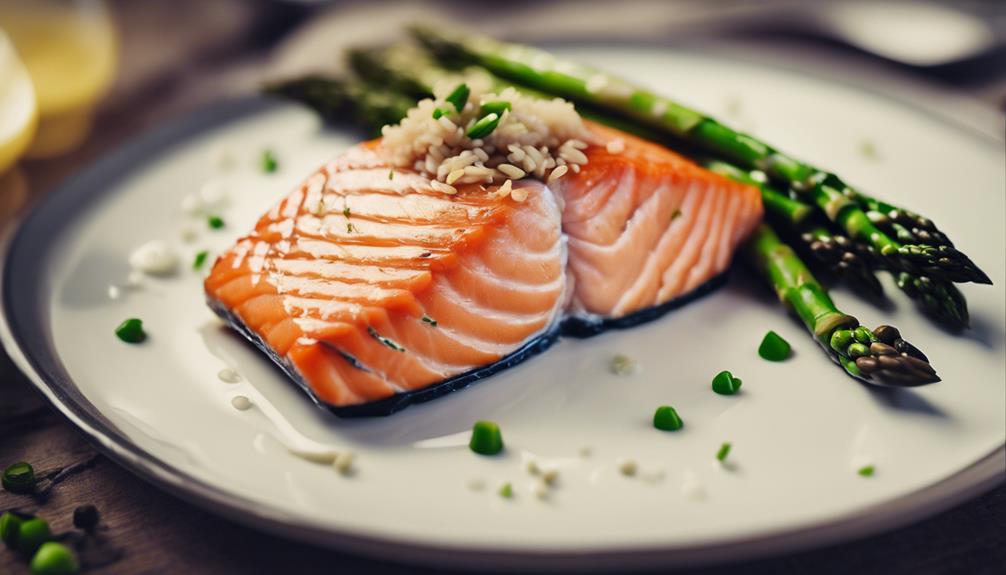
Discover some of the top-rated salmon dishes that will tantalize your taste buds:
Sous Vide Salmon With Asparagus, Savory Asparagus Stuffed Salmon, and Stuffed Salmon With Spinach.
These recipes offer a delightful mix of flavors and textures, perfect for those looking to elevate their salmon game.
Whether you prefer a classic preparation or a more innovative twist, these dishes are sure to impress even the most discerning seafood enthusiasts.
Sous Vide Salmon With Asparagus
Enhance your culinary repertoire with a flavorful sous vide salmon dish featuring tender asparagus. Sous vide cooking provides a unique method to secure in moisture and flavors, making this dish a healthy and delicious option for lunch.
Here are some tips to help you perfect your sous vide salmon with asparagus:
- Choose Fresh Ingredients: Select fresh salmon fillets and crisp asparagus spears for the best results.
- Season Thoughtfully: Season the salmon and asparagus with a blend of herbs and spices to enhance their natural flavors.
- Vacuum Seal for Precision: Use vacuum-sealed bags to guarantee precise cooking and flavor infusion.
- Set the Temperature: Set your sous vide machine to the recommended temperature for perfectly cooked salmon and tender asparagus.
- Finish with a Sear: After sous vide cooking, give the salmon a quick sear in a hot pan for a crispy exterior while keeping the inside moist and tender.
With these simple steps, you can create a delectable sous vide salmon dish that will impress your guests and elevate your cooking skills.
Savory Asparagus Stuffed Salmon
For a top-rated salmon dish that combines the flavors of savory asparagus and tender salmon, consider trying out the delightful recipe for Savory Asparagus Stuffed Salmon.
- Grilled Salmon: Begin by grilling the salmon fillets to perfection, creating a smoky flavor that complements the richness of the dish.
- Roasted Asparagus: Roast the asparagus until it's tender and slightly charred, adding a delicious crunch and earthy taste to the stuffed salmon.
- Assemble: Stuff the grilled salmon with the roasted asparagus, creating a mouthwatering combination of textures and flavors.
- Season: Season the dish with your favorite herbs and spices, enhancing the natural taste of the salmon and asparagus.
- Serve: Plate the savory asparagus stuffed salmon elegantly, ready to impress your guests with a dish that looks as good as it tastes.
Stuffed Salmon With Spinach
To continue exploring top-rated salmon dishes, consider trying out a flavorful recipe for Stuffed Salmon With Spinach that promises a delightful blend of ingredients and textures. This dish combines the richness of salmon with the earthy taste of spinach stuffing, creating a savory experience for your taste buds.
When preparing this dish, you have the flexibility to choose from various cooking methods such as baking, grilling, or pan-searing to suit your preferences.
Here are some tips to make your Stuffed Salmon With Spinach a success:
- Select Fresh Ingredients: Opt for fresh salmon fillets and vibrant spinach to enhance the flavors.
- Season Generously: Season the salmon and spinach stuffing with herbs and spices for a burst of flavor.
- Securely Seal the Ingredients: Make sure the spinach stuffing is securely enclosed inside the salmon fillets to prevent spillage during cooking.
- Monitor Cooking Time: Depending on the cooking method chosen, keep a close eye on the salmon to prevent overcooking.
- Serve with a Side: Pair your Stuffed Salmon With Spinach with a side of your choice for a well-rounded meal.
Sous Vide Salmon Techniques
When discussing sous vide salmon techniques, focusing on precision cooking temperature is crucial.
Vacuum sealing your salmon before cooking provides various advantages, including improved flavor infusion and moisture retention.
Managing the time and texture of your salmon is vital for consistently achieving the ideal sous vide dish.
Precision Cooking Temperature
Achieving the perfect cooking temperature is crucial for mastering sous vide salmon techniques. Temperature accuracy is key when using sous vide equipment, a modern cooking technology that allows precise control over the cooking process.
To cook salmon sous vide style, set the water bath to the exact temperature needed for the desired doneness of the fish. For salmon, a temperature range of 110°F to 130°F is ideal, depending on how you prefer the texture of your salmon – whether you like it more rare or well done.
This precision cooking guarantees that your salmon will be cooked perfectly from edge to edge, resulting in a moist and tender fillet every time. By maintaining a consistent temperature throughout the cooking process, sous vide technology ensures that your salmon will be cooked to perfection, making it a fantastic choice for serving a delicious and healthy meal to your guests.
Vacuum Sealing Benefits
For best results in your sous vide salmon techniques, consider the advantages of vacuum sealing. When you vacuum seal your salmon before cooking it sous vide, you're enhancing the flavor retention and moisture preservation of the fish. Vacuum sealing helps to lock in the natural juices and flavors of the salmon, resulting in a more succulent and tasty dish for you to enjoy.
By vacuum sealing your salmon, you're creating an airtight environment that prevents the loss of moisture during the cooking process. This guarantees that your salmon remains tender and moist, without drying out or becoming tough. Additionally, the vacuum seal helps to intensify the flavors of any seasonings or marinades you have added to the salmon, providing a more robust taste experience.
Incorporating vacuum sealing into your sous vide salmon techniques is a simple yet effective way to elevate the quality of your dish. Try vacuum sealing your salmon before cooking it sous vide next time to experience the benefits of flavor retention and moisture preservation firsthand.
Time and Texture Control
To guarantee precise control over both the cooking time and texture of your sous vide salmon, adjust the temperature settings accordingly. Time management is key when preparing sous vide salmon; by setting the temperature precisely, you can secure that the fish cooks to perfection without overdoing it.
This method allows you to infuse flavors deeply into the salmon, enhancing its taste and ensuring a moist and tender result.
Final Thoughts

In conclusion, contemplate the simplicity and health benefits of incorporating this Sous Vide Salmon With Asparagus and Brown Rice dish into your 80/20 diet. By choosing this meal, you aren't only embracing a delicious and nutritious option but also supporting your overall well-being. The final thoughts on this culinary choice revolve around the positive impact it can have on your health journey.
The health benefits of this Sous Vide Salmon With Asparagus and Brown Rice dish are abundant. The salmon provides essential omega-3 fatty acids that support heart health and brain function. Asparagus is rich in vitamins and antioxidants, promoting a strong immune system and healthy digestion. Brown rice offers fiber for sustained energy levels and digestive regularity.
Together, these ingredients create a balanced meal that nourishes your body from within.
Frequently Asked Questions
Can I Substitute Salmon With Another Type of Fish?
If you're considering swapping salmon with another fish, explore options like trout or cod based on flavor preferences. Guarantee the cooking technique aligns; for sous vide, choose a fish with a similar texture. Consider nutritional benefits to maintain a balanced diet.
Is It Necessary to Marinate the Salmon Before Cooking?
For your salmon, marinating benefits go beyond flavor. It tenderizes and enhances taste. While not necessary, it boosts the overall experience. Experiment with different marinades to find what suits your palate best.
How Long Can I Store Sous Vide Salmon in the Fridge?
You can store sous vide salmon in the fridge for up to 3 days. Proper storage is key; keep it sealed in an airtight container. Check for freshness indicators like smell and color before consuming.
Can I Use White Rice Instead of Brown Rice?
Yes, you can use white rice instead of brown rice. White rice lacks some nutrients found in brown rice but is still a good source of energy. Consider mixing with other nutrient-rich foods for a balanced meal.
Is It Possible to Cook the Salmon Without a Sous Vide Machine?
Yes, you can cook the salmon without a sous vide machine. Try oven baking or pan searing for delicious results. Both methods are user-friendly and can help you create a tasty meal without the need for specialized equipment.
Conclusion
To sum up, sous vide salmon with asparagus and brown rice is a delicious and nutritious meal option for those following the 80/20 diet.
By using precise cooking techniques and incorporating quality ingredients, you can enjoy a flavorful dish that's both satisfying and healthy.
Whether you're a seasoned chef or just starting out in the kitchen, this recipe is a great way to explore new flavors and elevate your culinary skills.
Give it a try and savor the taste of success!
